OCZ Vertex 4 Review (256GB, 512GB)
by Anand Lal Shimpi on April 4, 2012 9:00 AM ESTAnandTech Storage Bench 2011 - Light Workload
Our new light workload actually has more write operations than read operations. The split is as follows: 372,630 reads and 459,709 writes. The relatively close read/write ratio does better mimic a typical light workload (although even lighter workloads would be far more read centric).
The I/O breakdown is similar to the heavy workload at small IOs, however you'll notice that there are far fewer large IO transfers:
| AnandTech Storage Bench 2011 - Light Workload IO Breakdown | ||||
| IO Size | % of Total | |||
| 4KB | 27% | |||
| 16KB | 8% | |||
| 32KB | 6% | |||
| 64KB | 5% | |||
Our light workload is far more representative of a mainstream client workload (read heavy) and this is where the Vertex 4's sequential read performance hurts it the most. The Samsung SSD 830 ends up being considerably faster here. Once again, if we look at the breakdown of reads and writes we see why:
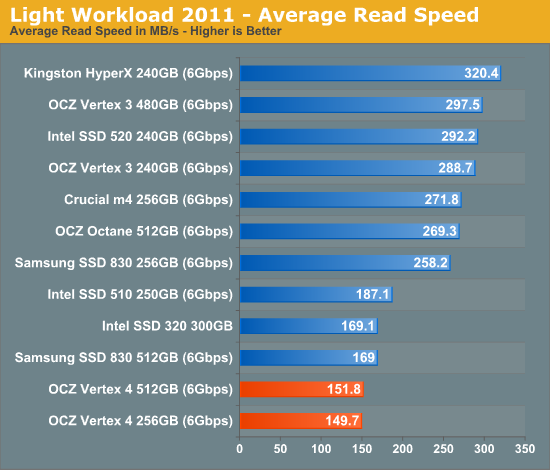
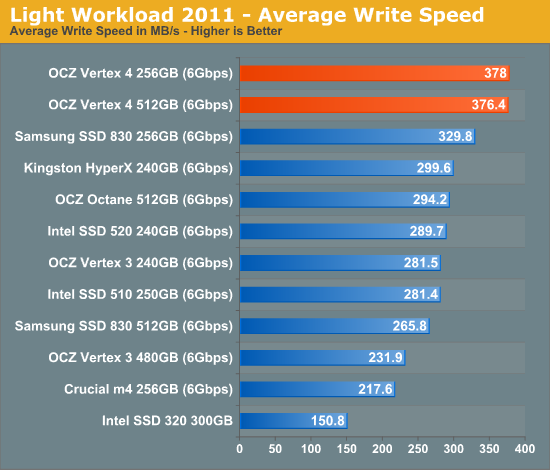
Read performance is around half of the best performers, while write speed is around 30% better. The combination results in competitive but not class-leading performance.If OCZ is able to deliver, at a minimum, Octane levels of read performance, the Vertex 4 should find itself much higher in the overall charts.
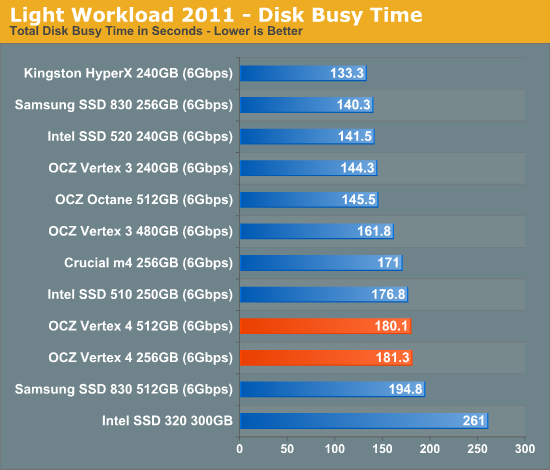
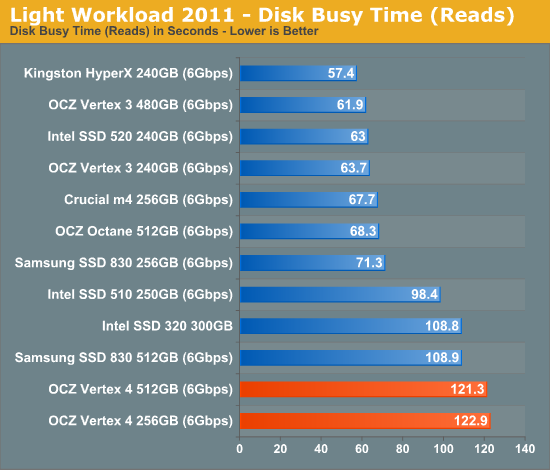



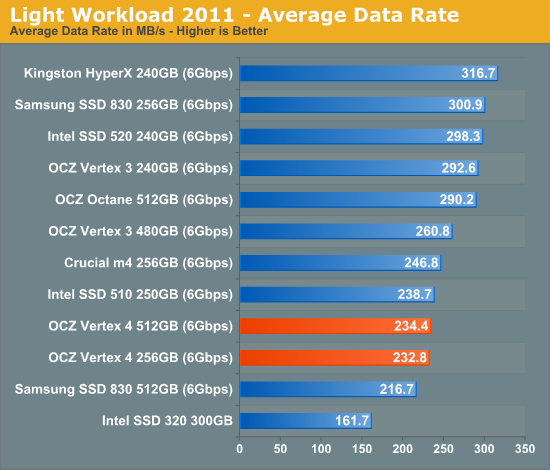








127 Comments
View All Comments
RussianSensation - Wednesday, April 4, 2012 - link
It seems after extensive use and degradation, the Corsair Performance Pro is one of the best, even besting the Crucial M4:http://www.xbitlabs.com/articles/storage/display/m...
meloz - Wednesday, April 4, 2012 - link
What's the deal with using such an enormous SoC built on 65nm process?I can understand OCZ / Indilinx not willing to shell premium for cutting edge 28nm process, but they could have at least used 45nm process.
With a 45nm process the SoC would be a lot smaller, thermal management would be easier (and cheaper), and power consumption would be lower (firmware update or not).
The cost of more modern process is easily balanced by the fact that they would get a lot more chips of a 300nm wafer with 45nm rather than 65nm.
Vertex 4 is a good improvement from OCZ, but they need to get serious about their execution and 'little details' if they still want to exist in another 5 years. Marvell, SandForce and Intel are not standing still and as competition increases the price of such poor decisions will weigh heavily against OCZ.
Ryan Smith - Thursday, April 5, 2012 - link
While we obviously can't speak for OCZ, when it comes to processes do keep in mind that costs escalate with the process. Older processes are not only cheaper because they have effectively reached their maximum yields, but the cost of their development has always been paid off, allowing the fabs to sell wafer runs at a lower cost and still book a profit.For a sufficiently simple device, the additional number of dice per wafer may not offset the higher per-wafer costs, lower yield, and demand-driven pricing. 4x nm processes are still booked solid, and will be for some time.
NCM - Wednesday, April 4, 2012 - link
Firmware "promises" aren't worth the guarantee they're not written on.We buy today's product, not the product there might be in some indefinite future.
rw1986 - Wednesday, April 4, 2012 - link
seems intel NAND would cost more and OCZ buys most of their NAND from Micron I believeKristian Vättö - Wednesday, April 4, 2012 - link
Without knowing the prices, it's hard to say anything. Intel and Micron NAND come from the same fab so the silicon quality is the same. Intel does rate their NAND higher (5000 vs 3000 P/E cycles) and both companies have their own validation processes, so it's possible that Intel NAND is slightly higher quality.It's possible that OCZ sources NAND from several fabs for the Vertex 4. E.g. Vertex 3 used NAND from Intel, Micron, Spectec and Hynix. Micron NAND is available in higher quantity as they own more plants, so that's why it's more common. Price wise I guess they are all about the same, though.
bji - Wednesday, April 4, 2012 - link
Any time a drive has a significant amount of RAM in it, I get a bit worried about the possibility of data loss on power outage. If the drive has the name OCZ attached, this worry becomes a huge concern. I would not be at all surprised if OCZ increased performance in part by reducing durability in the face of power outage.If the RAM is used as a write buffer, then on power outage the data is lost. This is not a problem if the drive correctly reports this state to the operating system - i.e., not telling the operating system that the data is sync'd to permanent storage until it's been written out of RAM cache into the flash cells. But if the drive cheats by telling the operating system that the blocks have been written when they have been stored in its RAM rather than when the blocks have actually made it to the flash cells, then data can be lost despite the guarantee that the drive has given that it can't.
Cheating in this way could make write performance look better, and given that the drive looks particularly good for write performance and has a lot of RAM on board, I am very, very suspicious.
What about testing this drive's durability in the face of power loss?
geddarkstorm - Wednesday, April 4, 2012 - link
That's a good question.However, from the article it sounds like the RAM is mostly being used to prefetch reads, rather than buffer writes.
bji - Wednesday, April 4, 2012 - link
That's Anandtech's conjecture. Even if OCZ told them it was so, it's not proven, as OCZ could be lying to cover the deficiency.FunBunny2 - Wednesday, April 4, 2012 - link
Exactly!! An "Enterprise SSD" with no superCap?? That needs some 'splainin.